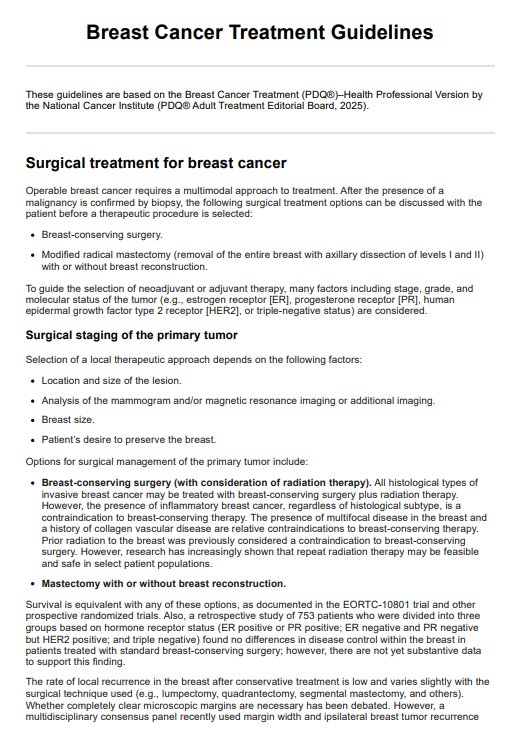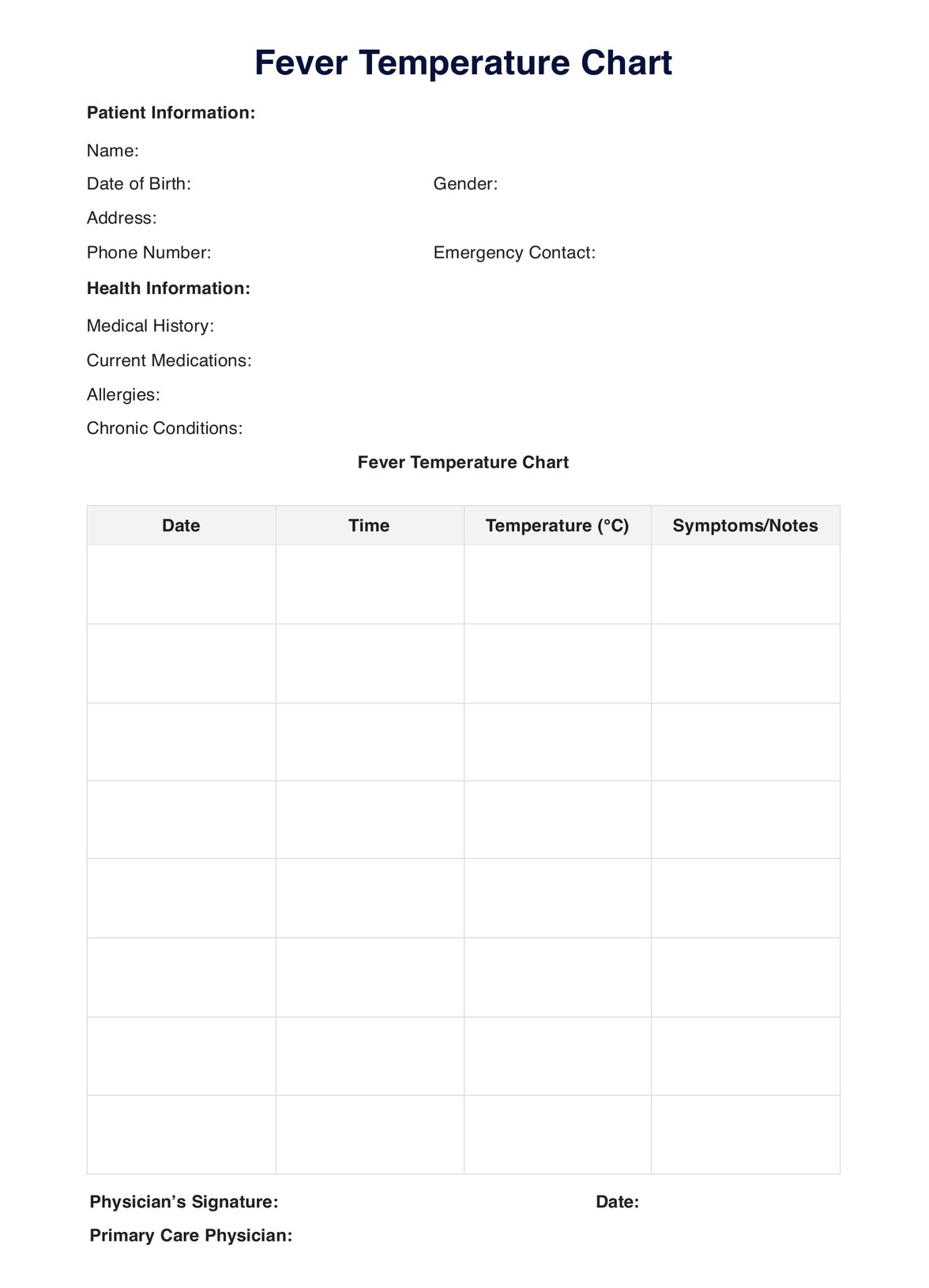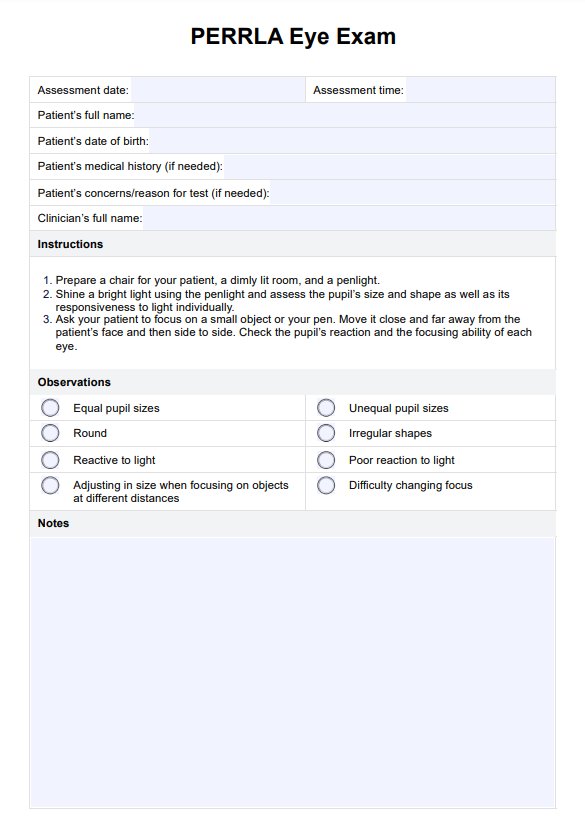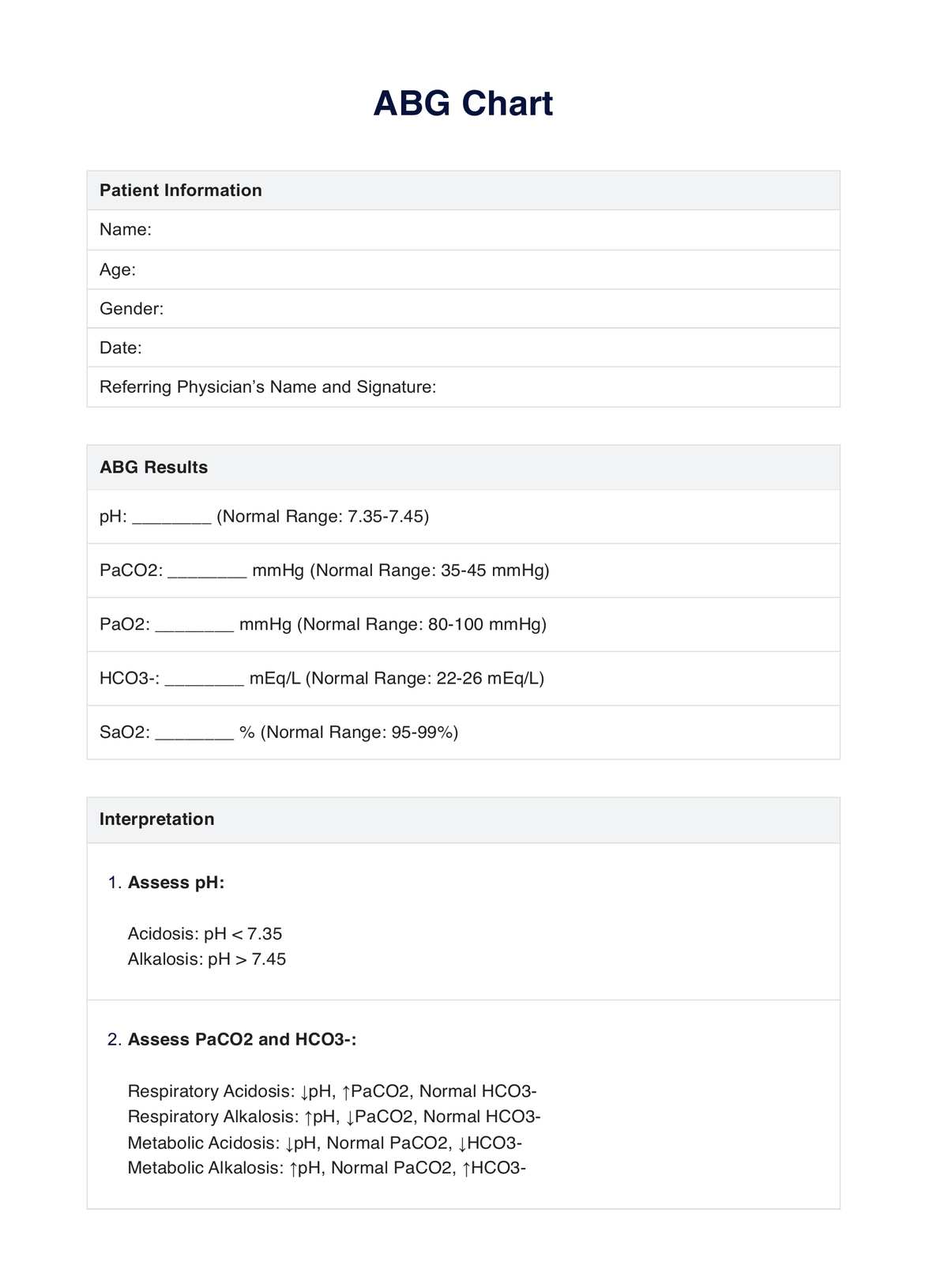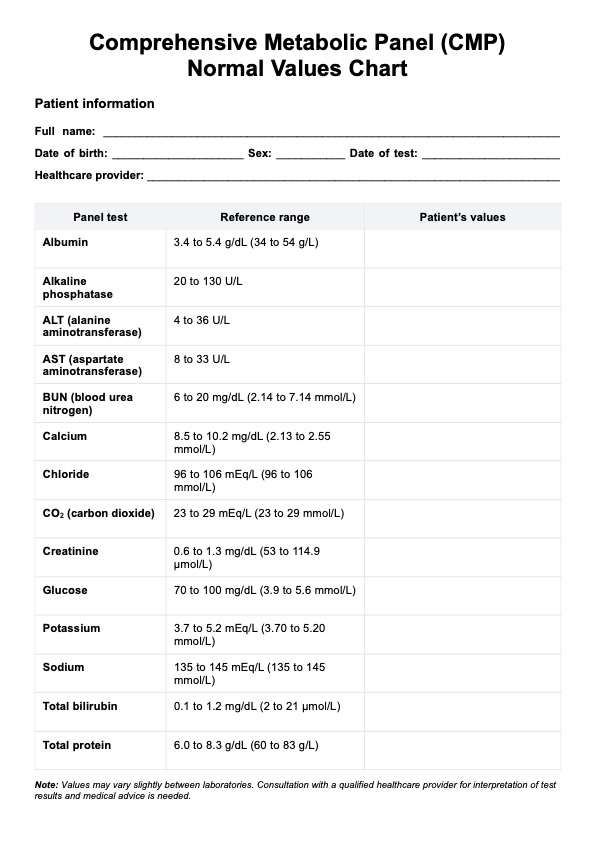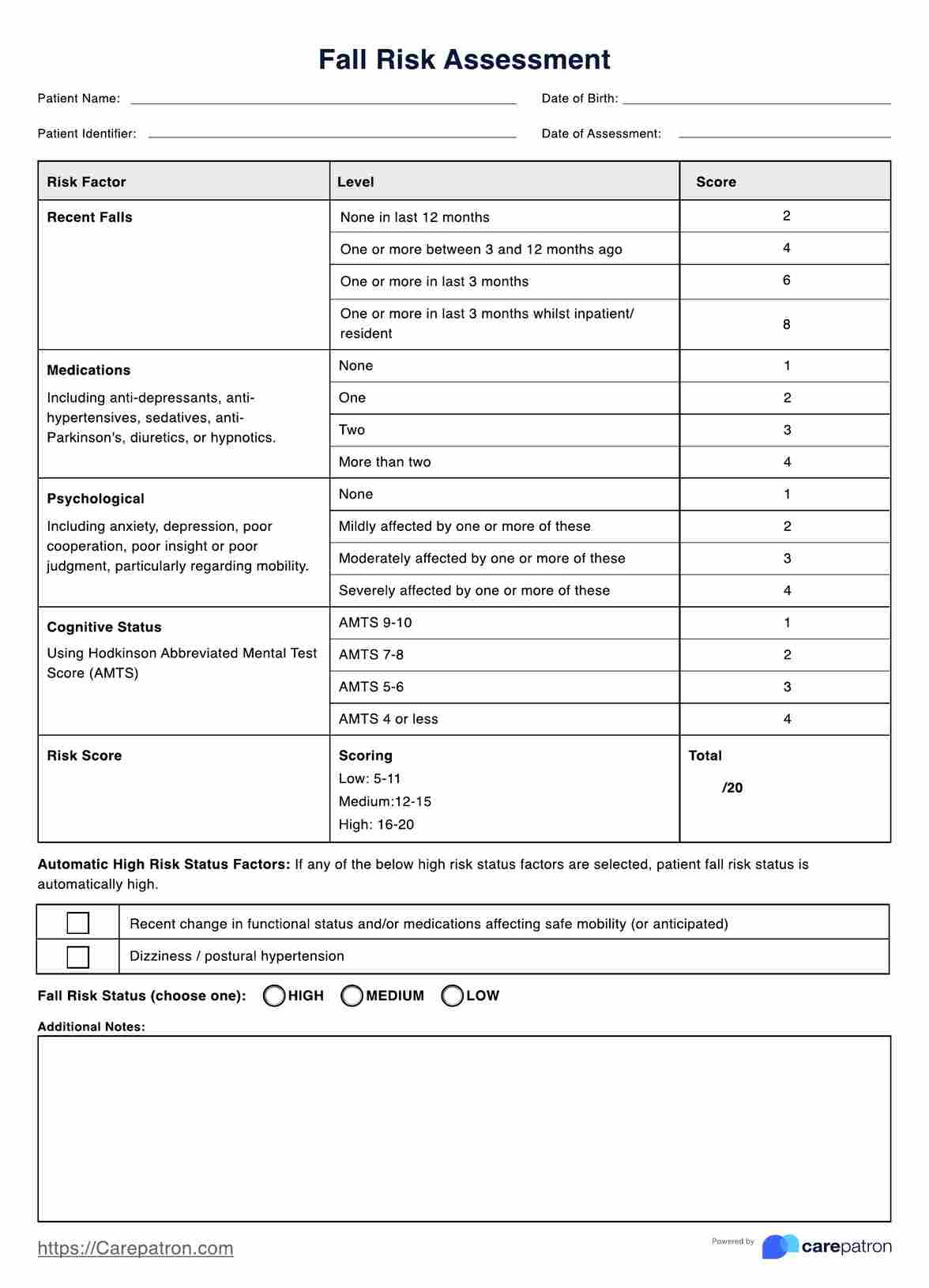Breast Cancer Treatment Guidelines
Explore comprehensive Breast Cancer Treatment Guidelines for informed decisions. Learn about the latest protocols and options for adequate care.


What is breast cancer?
Breast cancer is a malignant tumor that forms in the cells of the breast. It is the most common cancer among women worldwide, impacting millions each year. Breast cancer occurs when abnormal cells in the breast grow out of control, forming a lump or mass. This disease can spread to other body parts if not detected and treated early.
There are various types of breast cancer, including ductal carcinoma in situ (DCIS), invasive ductal carcinoma (IDC), and invasive lobular carcinoma (ILC). Metastatic breast cancer, also known as stage IV breast cancer, occurs when cancer cells spread beyond the breast to other organs like the lungs, liver, or bones. Inflammatory breast cancer is a rare and aggressive form of recurrent breast cancer characterized by redness, swelling, and warmth in the breast.
Treatment options for breast cancer depend on several factors, including the type and stage of cancer, as well as the patient's overall health and preferences. Common treatments include surgery, radiation therapy, systemic therapy (such as chemotherapy, hormone therapy, or targeted therapy), and adjuvant therapy to prevent recurrence.
Early detection through screening mammograms and self-exams are crucial for improving breast cancer outcomes. Awareness campaigns and research efforts by organizations like the National Cancer Institute and the National Comprehensive Cancer Network are vital in advancing breast cancer prevention, diagnosis, and treatment strategies.
Stages
Breast cancer stages indicate the extent of the disease, guiding treatment decisions and prognosis. The stages range from 0 to IV, each representing different levels of the breast cancer risk spread.
- Stage 0: DCIS is non-invasive and confined to the milk ducts.
- Stage I: Cancer is small and localized to the breast, not spreading to lymph nodes or nearby tissues.
- Stage II: Cancer is larger and may involve nearby lymph nodes but has not spread to distant organs.
- Stage III: Also known as locally advanced breast cancer, it has spread to lymph nodes or nearby tissues extensively.
- Stage IV: Metastatic breast cancer, where cancer has spread to distant organs like the lungs or bones.
Determining early-stage breast cancer often involves imaging tests, biopsies, and evaluation of lymph node involvement. ICD-10-CM codes provide a standardized system for documenting and coding diagnoses, including breast cancer stages, facilitating accurate medical record keeping and billing.
Understanding the stage of breast cancer is crucial for developing personalized treatment plans and predicting outcomes. Early detection and intervention improve the chances of successful treatment and long-term survival.
Breast Cancer Treatment Guidelines Template
Breast Cancer Treatment Guidelines Example
Types of breast cancer
Breast cancer encompasses various subtypes, each with distinct characteristics and treatment approaches.
- Ductal carcinoma in situ (DCIS): Non-invasive cancer confined to the milk ducts, considered the earliest form of breast cancer.
- Invasive ductal carcinoma (IDC): The most common type, originating in the milk ducts and infiltrating surrounding breast tissue.
- Invasive lobular carcinoma (ILC): Begins in the milk-producing glands (lobules) and can spread to nearby tissues.
- Triple-negative breast cancer (TNBC): Lacks estrogen, progesterone, and HER2 receptors, limiting treatment options, but often responds well to chemotherapy.
- Hormone receptor-positive (HR+) breast cancer: Contains estrogen and/or progesterone receptors, making it susceptible to hormone therapy.
- HER2-positive breast cancer: Overexpresses the HER2 protein, leading to aggressive growth, but targeted therapies like Herceptin are effective.
- Inflammatory breast cancer (IBC): Rare and aggressive, presenting with redness, swelling, and warmth due to cancer cells blocking lymph vessels.
Accurate diagnosis, including hormone receptor and HER2 status, is essential for tailoring treatment. Treatment of invasive breast cancer may involve surgery, chemotherapy, radiation therapy, hormone therapy, targeted therapy, or a combination, depending on the subtype and stage of breast cancer.
Diagnosing breast cancer
Diagnosing breast cancer relies on a multifaceted approach, incorporating various screening and diagnostic tests. Mammography is the primary screening tool, detecting abnormalities like lumps or calcifications. If suspicious findings emerge, additional imaging tests such as ultrasound or MRI may be recommended to assess the breast tissue further.
A definitive diagnosis often requires a biopsy, where a sample of the suspicious tissue is extracted and examined under a microscope by a pathologist. This biopsy helps determine the presence of cancer cells and provides crucial information about hormone receptor status, such as the estrogen receptor and progesterone receptors.
Additional tests like sentinel lymph node biopsy may be performed for accurate staging to assess lymph node involvement. Once diagnosed, treatment options, including surgery, chemotherapy, radiation therapy, and endocrine therapy, are tailored to the individual patient's needs, considering factors such as tumor characteristics and overall health.
Efficient and accurate diagnosis is paramount in guiding appropriate treatment strategies and improving outcomes for breast cancer patients, underlining the importance of regular screening and prompt medical evaluation.
What is included in the treatment guidelines for breast cancer?
The evolution of breast cancer treatment is a testament to the relentless pursuit of medical excellence, integrating groundbreaking research and patient-centric approaches. The National Cancer Insitute's treatment guidelines (2024) assist healthcare professionals through the multifaceted process of developing invasive breast cancer and delivering optimal care to breast cancer patients.
Early/localized/operable breast cancer treatment guidelines
Treatment options for early, localized, or operable breast cancer include surgery, postoperative radiation therapy, postoperative systemic therapy, and preoperative systemic therapy. Surgery options range from breast-conserving surgery (lumpectomy) to modified radical mastectomy. Postoperative radiation therapy varies based on axillary node status, with different approaches for node-negative and node-positive cases.
Postoperative systemic therapy depends on factors like tumor stage, grade, and molecular status, and may include tamoxifen, aromatase inhibitors, ovarian function suppression, and chemotherapy. Preoperative systemic therapy options include chemotherapy, HER2-targeted therapy, and endocrine therapy.
Treatment of locally advanced or inflammatory breast cancer
For locally advanced or inflammatory breast cancer, multimodality therapy is the standard of care with curative intent. Treatment options include breast-conserving surgery or total mastectomy with axillary lymph node dissection, chemotherapy, radiation therapy, and hormone therapy. Initial surgery typically involves biopsy for tumor evaluation.
Chemotherapy regimens mirror those used in the adjuvant setting. For responsive tumors, local therapy may follow chemotherapy, with options like mastectomy or breast-conserving surgery followed by radiation therapy. Hormone therapy is administered for ER-positive tumors.
Treatment of locoregional recurrent breast cancer
For locoregional recurrent breast cancer, treatment aims to control the disease, though rarely curative. Restaging before treatment is crucial. Therapy options include chemotherapy, hormone therapy, radiation therapy, surgery, and targeted therapy. ER status may change, impacting treatment decisions.
Treatment selection considers recurrence site, disease-free interval, and previous responses. Local treatments like mastectomy may be considered. Specific treatments depend on the recurrence site; for example, chest wall recurrences may benefit from surgery or radiation. Clinical trials are recommended for all patients to explore evolving treatment options.
Treatment of metastatic breast cancer
For metastatic breast cancer, treatment options include hormone therapy, HER2-targeted therapy, CDK4/6 inhibitors, mTOR inhibitors, PIK3CA inhibitors, chemotherapy, immunotherapy, surgery for limited symptomatic metastases, radiation therapy for limited symptomatic metastases, and bone-modifying therapy for bone metastases. These therapies are often used in sequence or combination. It's crucial to confirm metastatic disease through cytological or histological testing, including ER, progesterone receptor, and HER2 statuses. Patients are encouraged to participate in clinical trials.
Treatment of ductal carcinoma in situ
For DCIS, treatment options include breast-conserving surgery or mastectomy with or without radiation therapy and adjuvant tamoxifen. Mastectomy used to be the standard, but studies support the efficacy of breast-conserving surgery plus radiation therapy. Tamoxifen reduces breast cancer events but doesn't improve survival. Trials are ongoing to assess different therapies' effectiveness. It's crucial to confirm DCIS through biopsy and consider factors like tumor size, margin width, and pathological classification for treatment decisions. Patients may opt for endocrine therapy after weighing its benefits and side effects.
How does the template work?
The provided template serves as a structured guide for healthcare professionals and patients alike, outlining the recommended treatment options for different stages and types of breast cancer. Here's how it works:
Step 1: Identify the stage and type of breast cancer
The template categorizes breast cancer into various stages and types, such as early/localized/operable, locally advanced, metastatic, locoregional recurrent, and DCIS. This categorization helps determine the appropriate treatment approach based on the specific characteristics of the cancer.
Step 2: Select the relevant section
Once the stage and type of breast cancer are determined, select the corresponding section from the template. Each section provides an overview of the recommended treatment options for that particular stage or type of breast cancer.
Step 3: Review the treatment options
Each section lists the treatment options hierarchically, with subheadings denoting different modalities such as surgery, radiation therapy, systemic therapy, and targeted therapy. Each treatment option is briefly described, providing healthcare providers and patients an understanding of the available choices.
Step 4: Consider patient-specific factors
While reviewing the treatment options, healthcare providers should consider patient-specific factors such as tumor characteristics (e.g., hormone receptor status, HER2/neu status), overall health status, and treatment preferences. These factors help in individualizing treatment decisions to optimize outcomes and patient satisfaction.
Step 5: Make informed treatment decisions
Based on the information provided in the template and considering patient-specific factors, healthcare providers and patients can collaboratively make informed treatment decisions. This may involve a combination of treatments tailored to the patient's unique situation, with the goal of achieving the best possible outcome while minimizing side effects and preserving quality of life.
Step 6: Stay informed about clinical trials
The template also emphasizes the importance of clinical trials in advancing breast cancer treatment. Healthcare providers and patients are encouraged to stay informed about ongoing clinical trials and consider participation when appropriate. Clinical trials offer the opportunity to explore new treatment strategies and contribute to advancing breast cancer care.
Benefits of having treatment guidelines
These guidelines encompass evidence-based recommendations derived from clinical research, expert consensus, and best practices in oncology care. Here are its benefits:
1. Standardized care delivery
Treatment guidelines ensure consistent and standardized care delivery for breast cancer patients, promoting uniformity in treatment approaches across healthcare settings.
2. Improved treatment outcomes
Following established guidelines enhances the likelihood of favorable treatment outcomes, optimizing patient care and prognosis based on evidence-based practices.
3. Enhanced quality of care
Guidelines facilitate the delivery of high-quality care by providing clear protocols, reducing variability in practice, and minimizing the risk of errors or omissions.
4. Streamlined decision-making
Healthcare providers benefit from guidelines as valuable reference tools, aiding in informed decision-making regarding diagnostic testing, treatment selection, and patient management.
5. Increased patient safety
Adherence to treatment guidelines promotes patient safety by minimizing potential adverse events or complications associated with deviations from established best practices, ensuring patients receive appropriate and evidence-based care.
Reference
National Cancer Institute. (2024). Breast cancer treatment (PDQ®) - NCI. National Cancer Institute. https://www.cancer.gov/types/breast/hp/breast-treatment-pdq#_1699
Commonly asked questions
Breast cancer treatment guidelines are typically developed by reputable medical organizations and expert panels comprising oncologists, surgeons, radiologists, pathologists, and other healthcare professionals specializing in breast cancer care. Organizations that produce such guidelines include the National Comprehensive Cancer Network (NCCN) and the American Society of Clinical Oncology (ASCO).
Breast cancer treatment guidelines are essential as they provide evidence-based recommendations derived from clinical research, expert consensus, and best practices. These guidelines help healthcare providers make informed decisions regarding breast cancer diagnosis, treatment, and management, improving patient outcomes and quality of care.
Breast cancer treatment guidelines are regularly reviewed and updated to incorporate new research findings, advances in medical technology, and changes in clinical practice. Updates typically occur annually or biennially to ensure the recommendations remain current and reflect the latest evidence-based practices.



